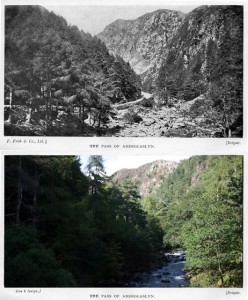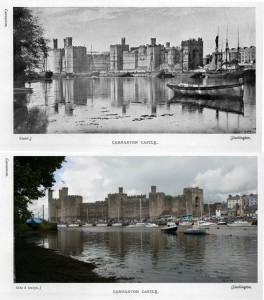Our new (old) awesome North Wales guide book doesn’t have a picture of Beddgelert itself. It does, however, tear apart the great legend of the place:
It seems cruel to spoil a pretty story, but truth must be told. About fifty years ago a writer is Welsh magazine showed that the legend was not founded on fact, and the Rev. A. Elvet Lewis, in a work published in 1899, entitled Bedd Gelert: Its facts, Fairies, and Folk-lore, gives wider publicity to its origin. He shows that the story, so far as it has local colour, is a growth of the nineteenth century; that before 1798 it was unknown in the neighbourhood; and that it was, in all probability, imported from South Wales by a certain David Prichard, who migrated north and became the first landlord of the Royal Goat Hotel at Beddgelert. Prichard came stocked with good stories from the southand among them was that of ‘the man who killed his greyhound’. He it was who fitted this particular folk-tale to the scene, and the dog to the name of Gelert; he who told the story to Spencer, the author of the familiar ballad; and he who, with the artistic completeness of the born myth-maker, aided by the parish clerk and another, raised the stone now exhibited on the spot known as the grave.
So there it goes. Legend gone. The tomb stone is still there though.
And a charming walk from there still takes you to the Aberglaslyn pass, just as all those years ago, and it even looks quite the same, except the trees have grown a lot.
…looking back from the romantic Pont Aberglaslyn we have an uninterrupted view of naked brown precipices rising to the sky beyond the fir trees and the dashing stream at our feet. (Teas and refreshments may be obtained at the bridge.)


